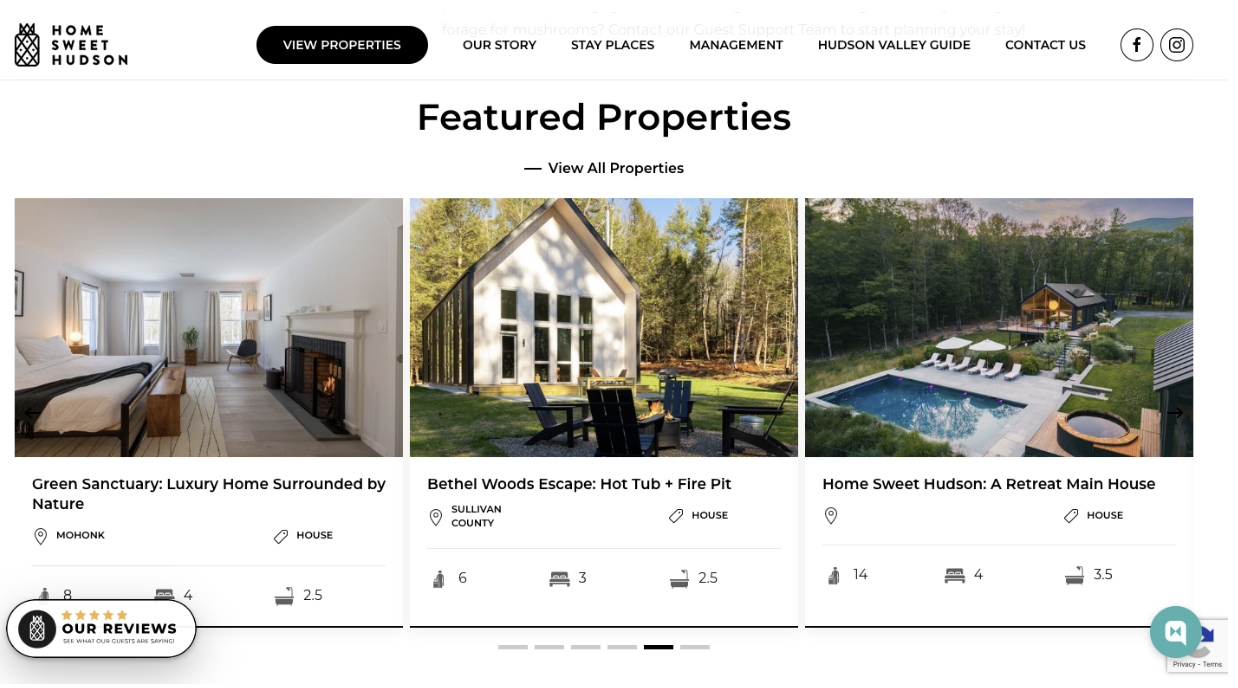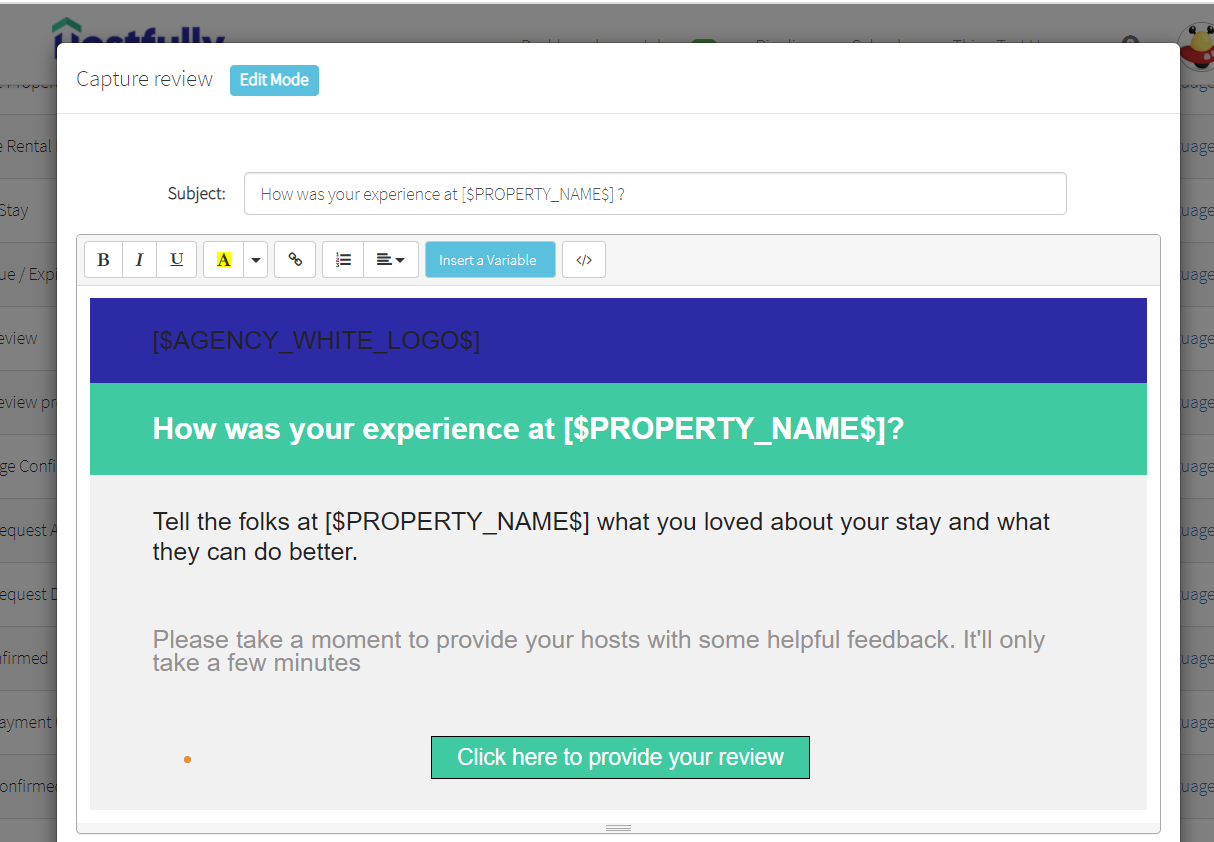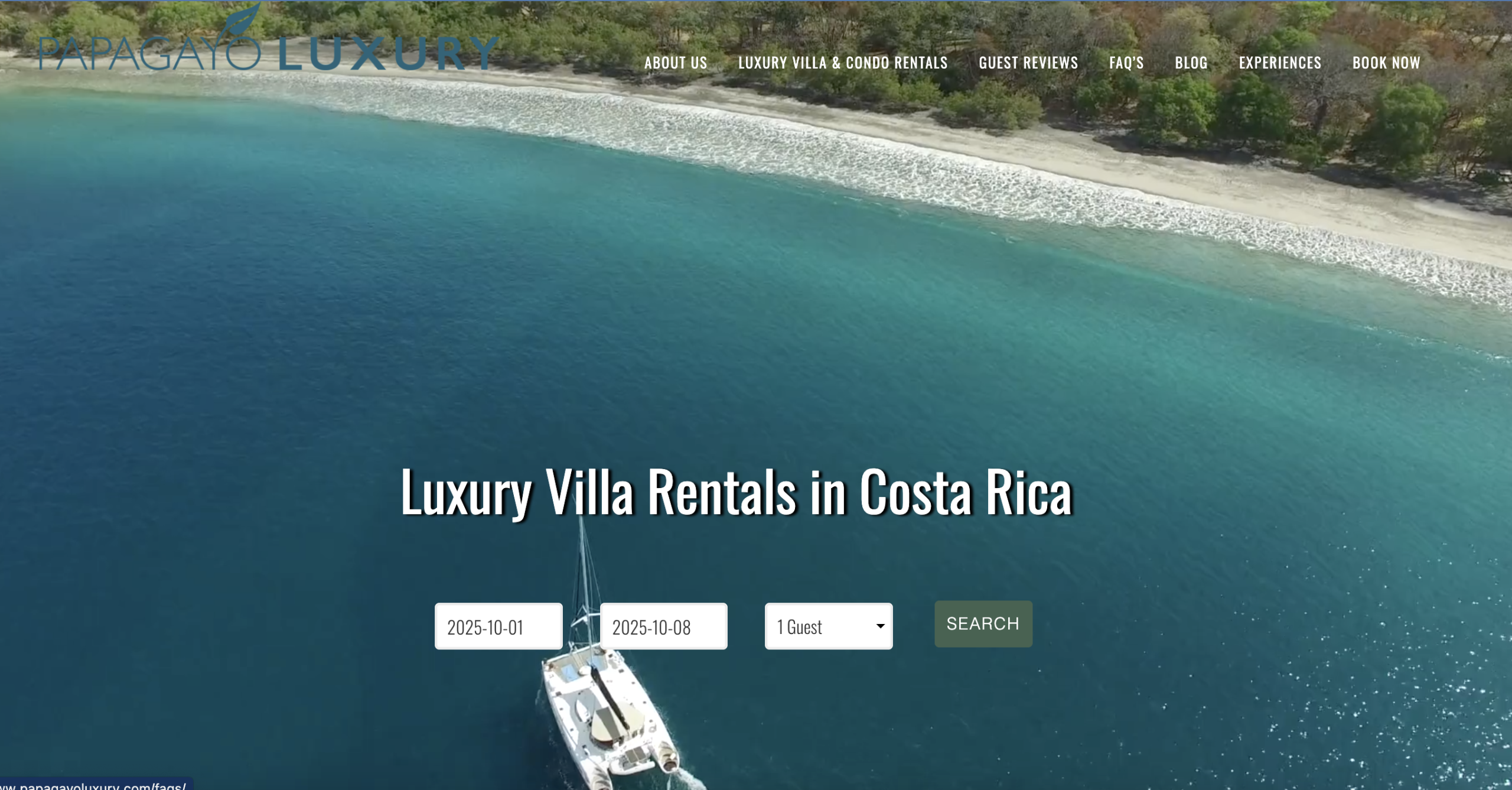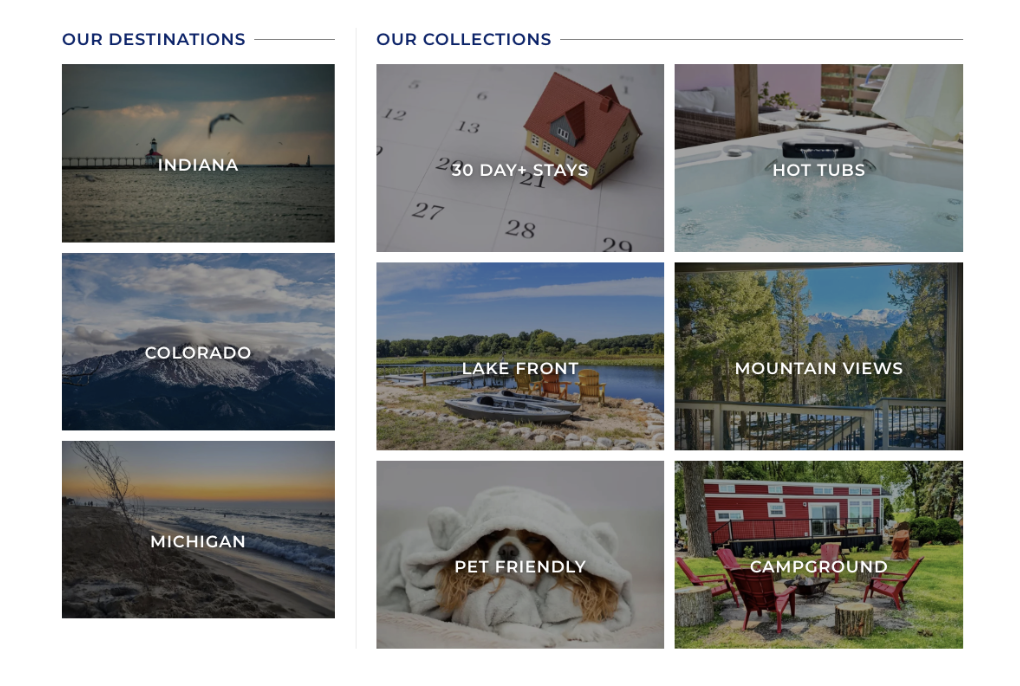Vacation rental management takes a lot of energy, and overseeing your website is just one more task. No wonder many hosts fall into the same trap: relying on OTAs that take a hefty commission or building a site that looks okay but doesn’t convince visitors to book.
But through our no-code website feature, Hostfully knows that you don’t need to be a marketer or software developer to optimize your short-term rental website. Just a few practical tips can help you rank well on Google, drive bookings, and reduce your dependency on listing sites.
Read our guide to see how to make your website stand out. We cover all the essential elements you need, quick strategies for getting clicks and bookings, and how to track your progress over time.
Why is an optimized vacation rental website important?
A great website draws more visitors to your website. Once they’re there, it encourages them to learn more about your business and make a direct booking.
But can’t you just optimize your listing pages? Although OTAs like Airbnb and Vrbo are great for attracting guests, they charge a small commission for every booking. These fees add up over time and significantly impact your bottom line.
Plus, OTAs are oversaturated, so you might be competing for space with hundreds of properties in your area. Newcomers to the vacation rental scene may take months, if not years, to catch up with established businesses with great ratings and reviews.
Many short-term operators are already moving away from OTAs. According to Hostfully’s 2024 Hospitality Trends report, our customers are taking up to 39% of bookings through their website now. Meanwhile, dependency on Airbnb has dropped by 8% in just two years.

What essential features does every vacation rental website need?
Websites are more than just digital brochures. Make sure you’ve incorporated these elements into yours to provide a smooth experience for potential guests.
- Mobile responsiveness: As of 2025, mobile devices are responsible for 64% of total internet traffic. Check your website design works on smartphones and tablets so nobody’s driven away by a bad user experience.
- Simple user-interface: Visitors should find information quickly. Organize your menu logically with clear headings so guests don’t get lost hunting for booking pages, pricing, or contact details.
- Fast loading speeds: Slow sites may frustrate visitors, so compress images, enable caching, and consider using a CDN to reduce loading times.
- Social media connections: Link your website to platforms like Instagram and Facebook, and embed social logos on your site to reinforce credibility and keep guests engaged.
- Guest reviews and testimonials: Feature positive feedback from past guests to build trust and show what kind of experience you can deliver. You can use a property management system (PMS) like Hostfully to prompt visitors for reviews, approve them, and publish them to your site.

9 tips on how to design a vacation rental website guests will love
These website features aren’t enough to stand out from the competition. Support them with the following strategies to boost your visibility on Google, make a great first impression, and increase direct bookings.
Ensure a smooth user experience
A frictionless web experience not only keeps guests engaged but also reduces bounce rates and booking abandonment. Ensure you have a clean layout, logical structure, and clear call to actions like “Book Now” to make navigation easier. You should also avoid clutter, like pop-ups and busy images, that distract visitors from booking.
Hostfully customer, Papagayo Luxury, has a great example of a user-friendly website. They have a minimalistic design that puts the booking process front and center while showcasing the area’s amazing ocean views.

Do a run-through of the booking process on your website before you go live. This gives you a chance to spot any unintuitive elements and fix them instead of leaving them for visitors to find.
Keep branding consistent
Maintain consistent branding across your website, listing pages, and social media to make your business easily recognizable wherever your guests find you. That means keeping the following brand elements the same:
- Color palette
- Photos and graphics
- Fonts
- Format
- Tone of voice
Listing pages don’t give you a lot of flexibility over branding, but you can achieve a lot with just the images and colors. Use the same photography style for all the shots of your properties, stamp your vacation rental logo in each corner, and incorporate your brand colors wherever possible into your interior design. No need to go overboard — basic consistencies in the style will make your vacation rental brand instantly recognizable.
Create compelling content
Content should answer the exact questions guests have before they book. Go beyond basic property descriptions by including details on amenities, local attractions, and what’s included in the stay. You can pair this with professional photography and images so guests can visualize your rental properties.
But don’t just state facts. Develop a unique tone of voice to represent your brand and keep guests engaged. You can match it to your location, property types, and aesthetic for full consistency.
For example, someone managing beachfront properties in Florida might want to use a casual, laid-back tone to suggest relaxed vibes. Whereas a business managing mountain cabin rentals in the Poconos where guests can do a lot of winter sports could adopt a more energetic style.
Showcase what makes you different
Guests might compare dozens of websites before making a decision. Make sure your properties stick in their memory by showcasing everything that makes your business unique.
For example, MTM Premier has a photo collage on their homepage that displays all their locations and standout property features. Visitors can instantly see that they offer mid-term stays, include hot tubs, and have pet-friendly policies.

Reinforce these unique features with social proof. You can include reviews that mention the same differentiators to prove that you can meet the expectations you’re setting on your webpage.
Read about how Hostfully helped MTM Premier Property Management reach 40% direct bookings.
Optimize for SEO
Follow SEO best practices to ensure your vacation homes rank first when people look for getaways in your local area. Here’s a list of the most impactful tips:
- Write descriptive meta titles and descriptions
- Incorporate keywords naturally into on-page text
- Organize your page using headers and sub-headers
- Use plenty of images with alt text
- Include internal and external links
- Build backlinks by partnering with local businesses and tourism boards
Again, you don’t need to be an SEO expert. A lot of strategy involves using common sense principles, like making all text clear and easy to follow and ensuring a logical navigation between pages.
Make your site visible to ChatGPT and other LLMs
Some guests are likely to find vacation home rentals through LLMs now. To increase your chances of being recommended by AI, structure your website with these tools in mind.
LLM optimization follows many of the same principles as SEO strategy. Just make sure your webpages are clear and well-formatted so they’re easy for AI to read. It’s also worth including an FAQ section that answers common questions like ‘When is check-in?’ or ‘What is your cancellation policy?’ as these are more likely to surface in search results.
Meet accessibility requirements
Accessibility is often overlooked, but it affects a large portion of your guests. Around 16% of the global population has a disability that could make it harder to process information on your site. To meet accessibility requirements, include the following:
- Provide alt text for images
- Include captions for videos
- Use sans-serif fonts like Arial
- Maintain a strong color contrast
- Ensure all forms and buttons are navigable by keyboard
- Avoid embedding text in images
Don’t forget about languages, too! If you serve international guests, offer multilingual content or enable translation features so they can still access the page. These steps not only broaden your reach but also signal inclusivity, making guests more comfortable booking with you.
Maintain strong security
Guests won’t book if they don’t trust your site. Secure your domain with SSL certificates so browsers display the padlock icon and ensure booking and payment pages use encrypted connections.
If you process credit card payments directly, use trusted providers like Stripe or Revolut. Leading PMS like Hostfully usually offer these as part of their integration marketplace. You can add as few or as many as you like you meet your guest’s needs.
Learn more about the +25 payment processors you can access as part of Hostfully’s integrations.
Sync your site with a channel manager
Use a channel manager like Hostfully to integrate your direct booking site with your PMS and other listing sites. This keeps your availability and rates consistent everywhere.
All you have to do is set your rates in your PMS. The software automatically updates OTAs like Airbnb and Vrbo and your vacation rental site instantly. That said, consider offering a small reduction on your own webpages to encourage guests to book directly.
How to analyze and refine website performance
What works well today might be ineffective in six months. That’s especially true in the fast-paced short-term rental industry where guest preferences change and evolving regulations influence what’s possible.
That’s why it’s essential to continuously monitor your performance and refine your strategies. Use tools like Google Analytics to see where traffic comes from, which pages keep visitors engaged, and where drop-offs happen. You can make edits and updates to ensure you always stay at the top of your guest’s search results.
Don’t forget to track performance through PMS like Hostfully. Metrics like number of direct bookings and Revenue Per Available Night (RevPAN) should tell you whether your website is having the right impact. With Hostfully, you even look at specific time periods, properties, and channels to get to the bottom of numbers.

Build a vacation rental website that drives bookings with Hostfully
Well-optimized websites ensure every visitor finds what they need, trusts what they see, and feels confident booking directly with you. But they call for a well-rounded strategy that considers SEO, graphic design, and user experience.
That’s where Hostfully comes in. Beyond powering direct bookings, our platform helps you connect all the moving parts of your business into one seamless system.
- Easily customizable booking pages display properties and accept reservations directly from your site.
- Channel management keeps calendars in sync across Airbnb, Vrbo, and your direct site so guests always see up-to-date availability.
- Payment processing tools give guests a secure checkout flow that cements trust.
- Analytics and reporting help you track performance and refine your website strategy over time.
Taken together, Hostfully’s range of features turns your vacation rental website into a reliable engine for direct bookings and long-term success.
FAQs about vacation rental websites
Do I need a website if I list on Airbnb and Vrbo?
Yes, you need a website to grow your short-term rental business. While Airbnb and Vrbo bring extra visibility, they control the customer relationship and charge a commission. A website gives you brand ownership, helps secure direct bookings, and reduces reliance on third parties.
What’s the easiest way to make a vacation rental website?
No-code website builders like Hostfully are the easiest way to make vacation rental websites. These tools allow you to add listings, calendars, and booking engines without requiring any technical expertise.
How long does SEO take for vacation rental sites?
SEO optimization usually takes a few months to have an impact. Small improvements can boost visibility in a matter of weeks, but you need to make a consistent effort to secure strong, lasting rankings.



